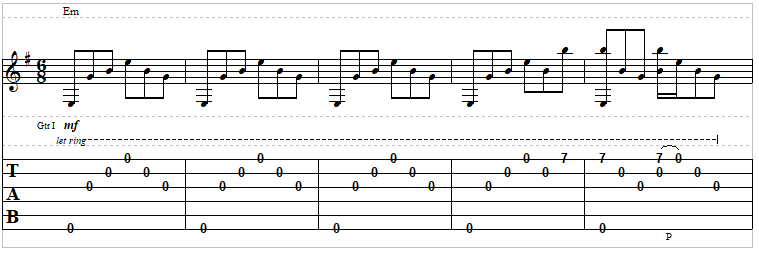Ok, we got that opening lick out of the way, so it’s all easier from here on out.
After the opening lick, we’ll spend two measures to establish the rhythm before the vocals come in.
It’s a slow shuffle pattern in the key of A.

Ok, we got that opening lick out of the way, so it’s all easier from here on out.
After the opening lick, we’ll spend two measures to establish the rhythm before the vocals come in.
It’s a slow shuffle pattern in the key of A.


“Bad to the Bone” is a song by George Thorogood and the Destroyers released in 1982. It was not a major hit on initial release, but later the video for the song made recurrent appearances on the MTV. Licensing for films, television, and commercials has since has helped make “Bad to the Bone” a staple of classic rock.
Note: This song is in open G tuning and uses a slide.
For open G tuning you will tune your guitar to D-G-D-G-B-D. I’ll show you how to tune to it in the following video.
Bad To The Bone (Complete Tab PDF)


Now, it’s time to put it together! Practice playing both parts together.


This intro from Stairway To Heaven has been the butt of a few jokes over the years because it seemed that every time you went to the music shop someone would be hunched overplaying it.
Maybe you’ll remember the scene from the movie “Wayne’s World”:
The tail end of the riff changes when leading into the interlude. It’s just a two-note walk (A and B note) into what will be a C in the next measure (not shown).


In the official recording, this riff is played with a device called a Talk Box. Since I don’t have access to a Talk Box at the time of this recording I cannot duplicate it exactly.


Skid Row was one of the last hair metal bands to hit the mainstream before grunge took over in the early ’90s. They were also arguably the last of such bands to have any originality. Their self-titled release used standard metal riffs and simple lyrics, but they broke away from the pop-metal that was going on with thrashy guitars and variances of ’80s metal formats. Their personal differences broke them apart in 1996, and Sebastian Bach went to work on acting, with little success.
The first three measures really don’t show much difference. The first measure has a hammer-on in it. A hammer-on is when you go from a lower note to a higher note, striking only the first note. Notice that at the top of the measures, chords are shown. The first three measures show the C#m chord and the B chord. All notes should be left ringing.
